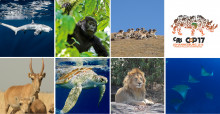The discussions at the 17th Conference of the Parties to the Convention on International Trade in Endangered Species of Wild Fauna and Flora (CITES) which began on 24 September in Johannesburg are of great relevance to CMS. CMS and CITES are the two major species-based global Conventions. CMS and CITES have around 500 species in common. Of the 183 countries that are Party to CITES, 123 are also members of CMS.



